 Who’s ready to boldly go where no one has gone before? If you are reading this, chances are you already know what Star Trek is. For over 50 years we’ve enjoyed the adventures of the crew of the Starship Enterprise (among others) throughout Gene Roddenberry’s universe.
Who’s ready to boldly go where no one has gone before? If you are reading this, chances are you already know what Star Trek is. For over 50 years we’ve enjoyed the adventures of the crew of the Starship Enterprise (among others) throughout Gene Roddenberry’s universe.
There have been quite a few Star Trek games over the years (of varying degrees of quality). Today, we are going to dive into Star Trek: Ascendency. Probably one of the deepest, most complex Star Trek games to ever make its way across our tabletop, and the first foray into the 4X genre for Star Trek. However, with a playtime of 3+ hours, this one isn’t for the casual fan. Is it worth the time commitment? Let’s find out.
Star Trek: Ascendancy is a 4x game for 3 players that takes about an hour per player to play. Right now, it only plays with 3 players exactly, but two upcoming expansions will expand the game to 3-5 players.
Game Overview:
Star Trek: Ascendancy is a 4x game of galactic exploration and conquest. If you aren’t familiar with the genre, 4x stands for: eXplore, eXpand, eXploit and eXterminate. It’s a style of game that has been around for a long time and garnered many fans.
Players will start off the game as a fledgling civilization of one of the 3 Star Trek powerhouses: Federation, Klingon or Romulan. Armed with just their home world, some tech, and a few ships, players will explore the galaxy, seeking to extend their reach.
Eventually players will learn newer and better tech, discover planets ripe for colonization, and finally meet each other. While some encounters might be peaceful, eventually combat will happen. Be prepared to fight your fellow player’s fleets, defend your planets from invasion and hopefully emerge from it all as the victor.
Game Components:
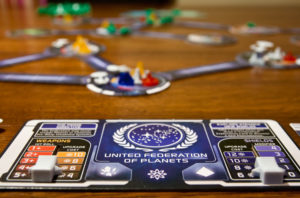
Star Trek: Ascendancy clocks in at a MSRP of $100 (although most people can probably find the game cheaper online), so I had high expectation for the components. Although I wasn’t too worried if the weight of the box in itself was any indication.
I’m not going to go over each component individually, as that would take forever, but suffice to say, gamers should feel like they are getting their money’s worth with this game.
Everything is decked out in a full Star Trek theme. From the custom starship minis, each stylized to represent their chosen faction, to the player dashboards. I liked how not only did each of the dashboards have a thematic feel to them that matches their faction, but also a special power and restriction. For example, the Federation is great at exploration, but can’t just invade pre-warp civilizations they discover. Stupid Prime Directive.
Between the ships, tokens, modular board, and cards, expect Star Trek: Ascendancy to be a table hog. But if you are a Star Trek fan, also expect to love poring over all the nice thematic touches in the game.
How to Play:
As I mentioned earlier, Star Trek: Ascendancy is a complex game. So I’ll give you a high level overview of how the game plays here, and if you’d like to get the full run down, you can get a PDF of the rulebook here.
Players in Star Trek: Ascendancy take control of one of the game’s 3 factions: Federation, Romulan or Klingon. Each players starts with their home planet, a piece of tech, some resources and a few ships.
Star Trek: Ascendancy is played over a series of rounds, each of which has 3 stages:
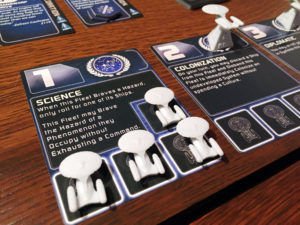
Initiative Stage:
This is where player order for the round is decided. If no players have made first contact (met another faction), then turn order cards are dealt out randomly. If any players have, they may bid resources for turn order.
Execution Stage:
This is where the main part of the game happens. Each player takes their full turn, based on their turn order card. A player’s turn is broken out into two phases:
Building Phase:
A player may Build Ships, Colonize a System, Build a Resource Node on one of their planets or Research new technology (either their tech cards or ship weapons/shield upgrades). Each of the above has a specific cost that a player must pay from their resource tokens (There are 3 resource types: Culture, Production, or Research). Players earn more resources via the nodes they have built on their planets.
Command Phase:
Each player starts the game with 5 Command tokens, and will acquire more as the game progresses. Doing any action in Star Trek: Ascendancy requires expending a Command Token.
Options Include:
Move Ships and Fleets: These can be moved through warp or at Impulse speed.
Start a Battle: Battles are handled via dice rolls. Upgrading your ships weapons will make it easier to hit, while upgrading your shields will make it harder for your opponents to hit you.
Invade a planet: Like ships battles, invasions are handled via simple dice rolls.
Attempt Cultural Hegemony: If you don’t want to take over a planet via military might, you can do it via diplomacy.
Commissions a Fleet or Starbase: You can combine multiple ships into a fleet to allow for easier movement. You can also build up to 3 starbases in the game. These aid in planetary defense and also provide a command token.
Launch a Project: Draw 2 cards from your tech deck and choose one to begin working on.
After one player finishes both their Building and Command Phase, the next player in turn order goes.
Recharge Phase:
Once all three players have finished their turn, the recharge phase happens. This is essentially a cleanup phase that has players: checking for victory, collecting resources and refreshing cards/tokens.
There are 2 ways to win Star Trek: Ascendancy. The first is to collect 5 Ascendancy tokens (These can be bought with 5 culture tokens). The second is to control all three homeworlds during the Recharge phase.
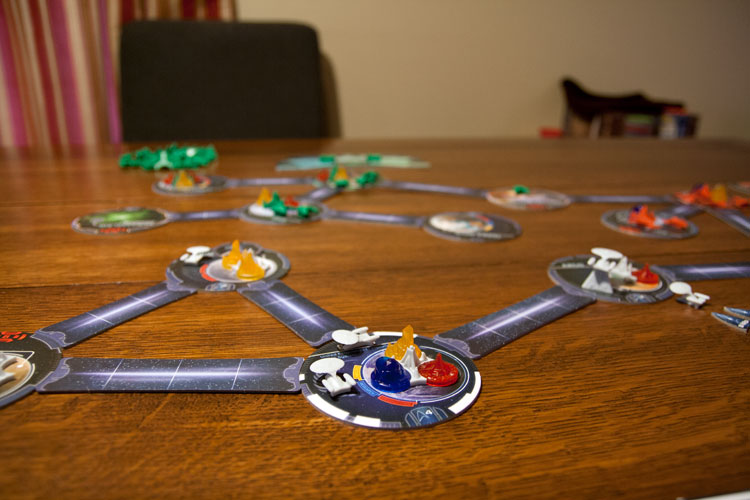
Game Experience:
If you don’t know anything about 4x games, they are usually long, complex games not for the faint of heart. Games of Twilight Imperium have been known to go for 8+ hours, so I wasn’t surprised when I saw Star Trek: Ascendancy clocking in at an hour per player. Our first game took closer to four hours once we added in the learning curve.
The interesting thing is that Star Trek: Ascendancy isn’t actually a difficult game. It’s complex, but it’s not necessarily complicated. There is just so much to do on your turn. From moving ships, to exploring new planets, to fighting off your enemies, expect to have a ready hard time deciding what to use your limited pool of command tokens on.
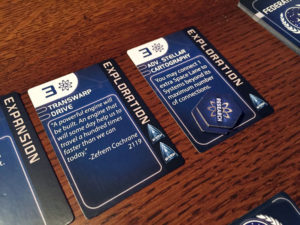
Speaking of exploration, that’s easily one of my favorite parts about Star Trek: Ascendancy. I LOVE the modular board. Each planet can have a number of “space lanes” connected to it. Once you decide to go off and explore, you randomly put a space lane out that will have from 2-4 spaces on it. Once you get to the end of the lane, you draw a planet and see what you discover. The neat thing about planets and space lanes is that they are moveable. Until a planet has 2 lanes attached to it, it can swing about on its one pivot point. This makes the galaxy very fluid as it grows. I really liked this aspect.
The second thing that I loved about Star Trek: Ascendancy is the uniqueness of the factions. I love asymmetrical games and each faction here will approach the game just a little bit different (and true to its roots). If you are the war monger of your group, you’ll grab the Klingon race, as most of their powers and tech are devoted to combat. Love technology? Go Romulan. Want to explore and spread your culture? The the federation is for you. Each of these races is really most optimal when played to their strengths.
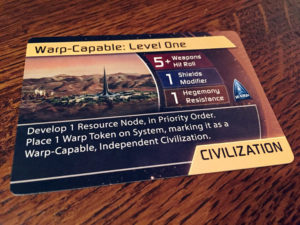
While Star Trek: Ascendancy has a lot of great things going for it, one thing that’s hard to get past is the downtime. While not the worst (especially once players are more experienced), it is a bit long. Expect to have a healthy bit of waiting when it’s not your turn, and unless someone attacks you, there isn’t really much for you to do. I’m curious if the downtime would have been better had players taken turns using 1 command token instead of doing their whole turn.
If I had to change something else, I probably would have gone with a tech tree over the random card draw. There were times, especially late in the game, when I drew a pair of tech cards that were of no use to me at that point in the game. I much prefer tech trees, especially in 4x games, where I can plan out my strategy and choose what tech I want to go for.
However, there is a way to mitigate that issue (and a few other flaws). Publisher Gale Force 9 has smartly added a variant section of the rule book. There are a number of rules in there to speed up the game, should you not have the 3+ hours needed to finish the game. Some are fairly benign, such as increasing your starting resources while others are more game changing, like reducing the cost of Ascendancy tokens. There is even an advanced rule that allows players to select their tech card instead of randomly drawing. I really liked this optional rules section and even used a few of these in our games.

Finally, let’s talk about the player count. I was a bit bummed that Star Trek: Ascendancy didn’t go down to two players. Three players, exactly, can be a bit hard to get to the table. That, and it can also have a “Gang up on the leader” tendency. It can also be easy for one player to turtle up, while the other two duke it out. Fortunately, there are two expansions coming down the pipeline that will add support for two more players with the Cardassian and Ferengi factions. However adding a 4th or 5th player is also going to increase the play time.
Final Thoughts:
Gale Force 9 has always been the King of Licensed Games in my opinion. Whenever they get their hands on a specific IP, they have some magic fairy dust that they sprinkle on the game that allows them to pull the roots of the source material out and make a highly entertaining game.
I was downright surprised when they pulled a great game out of WWE Wrestling, so I have exceedingly high expectations for a rich licensed game based on Star Trek. While Star Trek: Ascendancy isn’t perfect, it is still an incredibly enjoyable game that richly draws from its source material. If you can handle the downtime and length, there is a rewarding gaming experience here.
While I imagine the heavy rule set and long playtime will turn off more than a few Star Trek fans, for those of you looking for a 4x game that not only has a lot of depth, but a fantastic use of a beloved SciFi license, you need look no further. Star Trek: Ascendancy absolutely fits the bill.
If you’d like to pick up a copy of Star Trek: Ascendancy, you can get it for about $75.
Final Score: 4 Stars – A great 4x game that ties very well to its source material. Looking forward to trying out the forthcoming expansions.
 Hits:
Hits:
• Great use of the source material
• Lots of depth
• Enjoyed the modular galaxy
• Excellent components
Misses:
• Only plays with exactly 3 players
• Downtime gets a bit long










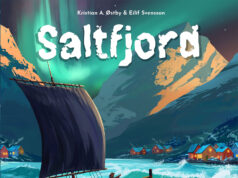
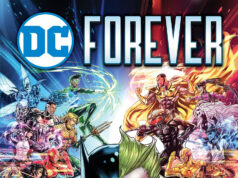












Great review, as usual. Looks good, but that downtime sounds rough. TI3 action selection would have solved this pretty well perhaps. Have you played Exodus much? How does STA compare?
Notes:
“If no players have made fist contact” (awesome typo).
“It’s complex, but it’s not necessarily complicated”.
I was a bit confused here. Did you mean that the game is ‘deep’ instead of complex here, as in has a lot of intersecting rules with a lot of strategic choices to be made? Or perhaps you were meaning that there were a lot of rules, but many theme and design aids made remembering those rules easy.
Thanks for the comment (and for catching the typo, which was awesome).
I haven’t played Exodus, so I can’t compare the two. Maybe someone else can chime in on that. Perhaps I’ll see about getting a copy of it.
For your other point, I see complex as different than complicated. A complex game might have a lot of rules and depth, but it still flows really well and isn’t necessarily hard to learn. It more speaks to the depth of choices.
A complicated game has a lot of rules, and can also be quite fiddly, meaning that it’s just not very elegant. So there might be a ton of things to reference on your turn, slowing the overall game down. In my mind Complex is better than Complicated.
Yeah, best typo I’ve seen in awhile. Exodus is super sleek. It has a lot of the depth and complexity of TI3, but in a lot shorter playtime. Hasn’t hit the table quite enough in our playgroup.
As for definitions, allow me to propose what I believe is a more broadly accepted definition for a few things, if you find that type of thing helpful. ‘Complex’ and ‘complicated’ are essentially the same word (hence my confusion), and they are defined as when game systems have lots of rules. Fiddliness speaks to when there are many exceptions to those rules, thus adding even more rules and increasing complexity. Simple games have few rules.
Now, on the other spectrum, depth is when there are a lot of valid strategic options available. The opposite, shallowness, is often due to overpowered options existing in a complex game, or there being too few options in a simple one .
Elegance is what happens when you have a simple rule-set with a lot of strategic depth. Of course, the entire thing is a gradient. What’s simple to one is complex to another.
Just my two cents in the event you find that type of thing helpful. Thanks again for the great review.
Hmm. I dug into it a bit more, unhappy with my reply. I think you’re correct in your usage of complex and complicated, although I find that they are used interchangeably far too often. That probably explains my initial confusion.
Complex is what I was defining, lots of rules, but this says nothing of how hard it is for someone to learn. Complicated should refer to the difficulty of learning a game. Complex games are often complicated, but there are a lot of tricks to making the rules easier to learn, design and theme being the two big ones, lack of fiddly rules being another.
So complexity definitely is correlated with complicated, more rules means more to learn, but they do not equate one for one as I had thought.
Also, depth really has little to do with the two. A deep game can be either simple or complex, easily learned or very complicated.
Woah! Now I know more things.
Thanks for the reply. I certainly appreciate your dedication to the cause. You definitely make some good points. 🙂
I played this game for my first time last night. Never played a game like this every in my life. I found it intriguing and a lot of fun. Took about an hour to figure it out but I think I got it. Still unsure how the battle sequences work with the dice but I’ll figure it out next time I play.
As a newcomer to the game I was impressed and my interest in the game remained focused. Learning the game and all of its rules was a bit overwhelming. It was just two of us playing the game and with the learning curve we finished after about 3 hours. I played Federation and my friend played Klingon. By luck of the dice and worlds discovered he totally kicked my ass! I’m going to have to try Romulan next!
Thanks for the review of the game! Can’t wait to play again!
I disagree with downtime and plays with exactly 3.,yes if you are talking just base.but played with 4 or 5 very well with expansions. And not sure how slow of layers you are.we have played nature game with 3mplayers in 60 to 90 minutes